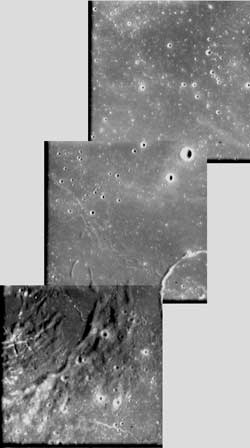Mare Humorum: where craters tell the story of basalt

Mare Humorum, or 'Sea of Moisture', is a small circular mare on the lunar nearside, about 825 kilometres across, filled with a thick layer of mare basalt, (possibly exceeding 3 kilometres in thickness at the centre of the basin). Mare Humorum is a scientifically interesting area because it allows the study of the relationships among lunar mare filling, mare basin tectonics, and global thermal evolution to the major mascon maria – that are regions of the moon's crust which contain a large amount of material denser than average for that area.
AMIE obtained the top frame on 1 January 2006, from a distance of 1087 kilometres from the surface, with a ground resolution of 98 metres per pixel. The remaining two frames were taken on 13 January 2006, from a distance of about 1069 (centre) and 1050 kilometres (bottom) from the surface, with a ground resolution of 97 and 95 metres per pixel, respectively.
The area shown in the top image is centred at a latitude of 40.2º South and longitude 25.9º West; the centre image is centred at a latitude of 40.2º South and longitude 27.3º West; the bottom image is centred at a latitude of 40.2º South and longitude 28.8º West.
Mare Humorum, or 'Sea of Moisture', is a small circular mare on the lunar nearside, about 825 kilometres across. The mountains surrounding it mark the edge of an old impact basin which has been flooded and filled by mare lavas. These lavas also extend past the basin rim in several places. In the upper right are several such flows which extend northwest into southern Oceanus Procellarum.
Mare Humorum was not sampled by the Apollo program, so its precise age could not been determined yet. However, geologic mapping indicates that its age is in between that of the Imbrium and the Nectaris basins, suggesting an age of about 3.9 thousand million years (with an uncertainty of 500 million years).
Humorum is filled with a thick layer of mare basalt, believed to exceed 3 kilometres in thickness at the centre of the basin. On the north edge of Mare Humorum is the large crater Gassendi, which was considered as a possible landing site for Apollo 17.
Mare Humorum is a scientifically interesting area because it allows the study of the relationships among lunar mare filling, mare basin tectonics, and global thermal evolution to the major mascon maria – regions of the moon's crust which contain a large amount of material denser than average for that area (Solomon, Head, 1980).
Past studies (Budney, Lucey) revealed that craters in the mare Humorum sometimes excavate highland material, allowing to estimate the thickness from below the mare cover. Thanks to this, it was also possible to determine that the ‘multiring’ structure of the Humorum basin has a diameter of 425 kilometres (results based on the US Clementine global topography data).
In general, the chronology of lunar volcanism is based on the analysis of landing site samples from the Apollo and Luna missions, from the study of the relationship between the stratigraphy (layering of deposits) in different regions, and from the analysis of lunar craters – how they degraded over time and how their distribution in number and size varies over the Moon’s surface. From crater statistics, in the year 2000 Hiesinger and colleagues found that in Humorum there was a peak of eruptions at about 3.3-3.5 thousand million years ago.
Media Contact
More Information:
http://www.esa.int/SPECIALS/SMART-1/SEMVMAA6CPE_0.htmlAll latest news from the category: Physics and Astronomy
This area deals with the fundamental laws and building blocks of nature and how they interact, the properties and the behavior of matter, and research into space and time and their structures.
innovations-report provides in-depth reports and articles on subjects such as astrophysics, laser technologies, nuclear, quantum, particle and solid-state physics, nanotechnologies, planetary research and findings (Mars, Venus) and developments related to the Hubble Telescope.
Newest articles

Recovering phosphorus from sewage sludge ash
Chemical and heat treatment of sewage sludge can recover phosphorus in a process that could help address the problem of diminishing supplies of phosphorus ores. Valuable supplies of phosphorus could…

Efficient, sustainable and cost-effective hybrid energy storage system for modern power grids
EU project HyFlow: Over three years of research, the consortium of the EU project HyFlow has successfully developed a highly efficient, sustainable, and cost-effective hybrid energy storage system (HESS) that…

After 25 years, researchers uncover genetic cause of rare neurological disease
Some families call it a trial of faith. Others just call it a curse. The progressive neurological disease known as spinocerebellar ataxia 4 (SCA4) is a rare condition, but its…





















